Switchable Liquid Crystal Contact Lenses for the Correction of Presbyopia
Abstract
1. Introduction
2. Smart Contact Lenses and Wearables
2.1. Requirements for a LC Contact Lens
2.2. LC Electro-Optic Devices and Lenses
3. Alignment Modes
- Vertical aligned nematic (VAN), where LCs with a negative ∆ε must be used.
- Planar-homogeneous aligned nematic (PAN), where LCs with a positive ∆ε must be used.
- Hybrid aligned nematic (HAN), where either LCs with a positive or negative ∆ε can be used.
3.1. LC Contact Lens Designs
- (1)
- (2)
- (3)
- (4)
3.2. Concave or Convex Solid LC Lenses
3.3. LC Diffractive Zone Plate
3.4. Fresnel Shaped LC Lenses
3.5. Electrode Patterned LC Lenses
3.6. Suitable Electrodes for LC Contact Lenses
4. Antenna and Communication
4.1. Powering the LC Lenses
- Batteries: Organic lithium hybrid batteries have been considered for wearable devices due to their high energy storage. These batteries can also be re-charged, which prolongs the longevity of the device. These polymer batteries are flexible and can be solution processed using inkjet printing, dispensing, screen printing, etc. [83,84]. The batteries must be carefully encapsulated to ensure no direct contact with the user. This is because these types of batteries could cause irritation if exposed directly to the user’s eye.
- Micro super capacitors: The chemical composition of super capacitors is much simpler than a polymer battery. They consist of at least two electrodes, which are separated by a dielectric membrane. For example, Le et al. demonstrated an in-plane capacitor using inkjet printed graphene [85]. The avoidance of hazardous material means that this solution is likely to be more acceptable than polymer batteries. However, at least one day’s charge would need to be stored in the capacitor. Storing large amounts of energy within a capacitor is not as stable as a battery, but it is able to deliver a quick burst of power quickly. Therefore, most of the power could be stored on a battery, which works in tandem with a capacitor when the device needs to be quickly switched on.
- Enzymatic fuel cells: Eyes are naturally lubricated with saline, which contains enzymes and electrolytes. Extensive work has been conducted into using the energy stored in these electrolytes to power wearable devices [86,87,88,89]. The chemical reaction would eventually deplete from the lenses, but it could be a suitable and passive way to power the lenses.
- Piezoelectric: Several companies have already been investigating the use of piezoelectric components within wearable devices to harvest energy while the device is being used [13,90]. The eye is constantly moving during blinking, turning, focusing etc. Larger movements, such as the user walking would also stimulate the piezoelectric components to charge the device. A battery or supercapacitor would also need to be included in this design since the piezoelectric components are not capable of constantly providing power. However, this storage component wouldn’t need to able to power the lens for a day by itself, as it would be intermittently recharged by the piezoelectric system.
4.2. Electronics, Interconnects and Vias
4.3. Triggering Mechanisms
4.4. Polarisation Independence
4.5. Improving Switching Off Times
5. Conclusions
Acknowledgments
Author Contributions
Conflicts of Interest
References
- Madrid-Costa, D.; García-Lázaro, S.; Albarrán-Diego, C.; Ferrer-Blasco, T.; Montés-Micó, R. Visual performance of two simultaneous vision multifocal contact lenses. Ophthalmic Physiol. Opt. 2013, 33, 51–56. [Google Scholar] [CrossRef] [PubMed]
- Morgan, P.B.; Efron, N. Contact lens correction of presbyopia. Contact Lens Anterior Eye 2009, 32, 191–192. [Google Scholar] [CrossRef] [PubMed]
- Antona, B.; Barra, F.; Barrio, A.; Gutierrez, A.; Piedrahita, E.; Martin, Y. Comparing methods of determining addition in presbyopes. Clin. Exp. Optom. 2008, 91, 313–318. [Google Scholar] [CrossRef] [PubMed]
- Blystone, P.A. Relationship between age and presbyopic addition using a sample of 3645 examinations from a single private practice. J. Am. Optom. Assoc. 1999, 70, 505–508. [Google Scholar] [PubMed]
- Li, G. Adaptive Lens. Prog. Opt. 2010, 55, 199–283. [Google Scholar]
- Li, G.; Mathine, D.L.; Valley, P.; Ayräs, P.; Haddock, J.N.; Giridhar, M.S.; Williby, G.; Schwiegerling, J.; Meredith, G.R.; Kippelen, B.; et al. Switchable electro-optic diffractive lens with high efficiency for ophthalmic applications. Proc. Natl. Acad. Sci. USA 2006, 103, 6100–6104. [Google Scholar] [CrossRef] [PubMed]
- Berreman, D.W. Variable Focus Liquid Crystal Lens System. U.S. Patent No. 4,190,330, 26 February 1980. [Google Scholar]
- Sato, S. Liquid-crystal lens-cells with variable focal length. Jpn. J. Appl. Phys. 1979, 18, 1679–1694. [Google Scholar] [CrossRef]
- Kern, S.P. Variable Power Lens System. U.S. Patent No. 4,601,545, 21 April 1986. [Google Scholar]
- Mansouri, K.; Medeiros, F.A.; Tafreshi, A.; Weinreb, R.N. Continuous 24-hour Monitoring of Intraocular Pressure Patterns With a Contact Lens Sensor. Arch. Ophthalmol. 2012, 130, 1534. [Google Scholar] [CrossRef] [PubMed]
- Otis, B.; Parviz, B. Introducing Our Smart Contact Lens. Available online: https://googleblog.blogspot.co.uk/ (accessed on 16 January 2014).
- Desney, T.; Kristin, T. Functional Contact Lens Monitors Blood Sugar without Needles. Available online: http://research.microsoft.com (accessed on 1 June 2011).
- Sako, Y.; Iwasaki, M.; Hayashi, K.; Kon, T.; Nakamura, T.; Onuma, T.; Tange, A. Contact Lens and Storage Medium. Patent Application No. US 2,016,097,940 (A1), 7 April 2016. [Google Scholar]
- Kim, D.H. Lens Assembly and Camera Module Including the Same. Patent Application No. US 20,160,178,874 (A1), 23 June 2016. [Google Scholar]
- Pugh, R.B.; Higham, C.A. Methods of Using and Smartphone Event Notification Utilizing an Energizable Ophthalmic Lens with a Smartphone Event Indicator Mechanism. Patent Application No. US 20,150,017,918 (A1), 15 January 2015. [Google Scholar]
- Pandey, J.; Liao, Y.T.; Lingley, A.; Mirjalili, R.; Parviz, B.; Otis, B.P. A fully integrated RF-powered contact lens with a single element display. IEEE Trans. Biomed. Circuits Syst. 2010, 4, 454–461. [Google Scholar] [CrossRef] [PubMed]
- De Smet, J.; Avci, A.; Joshi, P.; Cuypers, D.; De Smet, H. A Liquid Crystal Based Contact Lens Display Using PEDOT: PSS and Obliquely Evaporated SiO2. In Proceedings of the SID Display Week 2012, Boston, MA, USA, 3–8 June 2012; pp. 1375–1378. [Google Scholar]
- Milton, H.E.; Gleeson, H.F.; Morgan, P.B.; Goodby, J.W.; Cowling, S.; Clamp, J.H. Switchable liquid crystal contact lenses: Dynamic vision for the ageing eye. In Proceedings of SPIE; Chien, L.-C., Figueiredo Neto, A.M., Neyts, K., Ozaki, M., Eds.; SPIE: Bellingham, WA, USA, 2014; Volume 9004, p. 90040. [Google Scholar]
- Milton, H.E.; Morgan, P.B.; Clamp, J.H.; Gleeson, H.F. Electronic liquid crystal lenses for the correction of presbyopia. Opt. Express 2014, 22, 8035–8040. [Google Scholar] [CrossRef] [PubMed]
- Syed, I.M.; Kaur, S.; Milton, H.E.; Mistry, D.; Bailey, J.; Morgan, P.B.; Jones, J.C.; Gleeson, H.F. Novel switching mode in a vertically aligned liquid crystal contact lens. Opt. Express 2015, 23, 9911–9916. [Google Scholar] [CrossRef] [PubMed]
- Kaur, S.; Kim, Y.-J.; Milton, H.; Mistry, D.; Syed, I.M.; Bailey, J.; Novoselov, K.S.; Jones, J.C.; Morgan, P.B.; Clamp, J.; et al. Graphene electrodes for adaptive liquid crystal contact lenses. Opt. Express 2016, 24, 8782–8787. [Google Scholar] [CrossRef] [PubMed]
- Van der Worp, E.; Bornman, D.; Ferreira, D.L.; Faria-Ribeiro, M.; Garcia-Porta, N.; González-Meijome, J.M. Modern scleral contact lenses: A review. Contact Lens Anterior Eye 2014, 37, 240–250. [Google Scholar] [CrossRef] [PubMed]
- De Smet, J.; Avci, A.; Beernaert, R.; Cuypers, D.; De Smet, H. Design and Wrinkling Behavior of a Contact Lens With an Integrated Liquid Crystal Light Modulator. J. Disp. Technol. 2012, 8, 299–305. [Google Scholar] [CrossRef]
- Flitsch, F.A.; Otts, D.B.; Pugh, R.B.; Riall, J.D.; Toner, A. Biocompatibility of Biomedical Energization Elements. Patent Application No. US 2,016,056,417 (A1), 25 February 2016. [Google Scholar]
- Markus, D.T.; Hayes, M. Piezoelectric Energy Harvesting Contact Lens. Patent No. WO 2,016,014,118 (A1), 28 January 2016. [Google Scholar]
- Otts, D.; Pugh, R.; Flitsch, F.; Hardy, K. Methods and Apparatus to Form Printed Batteries on Ophthalmic Devices. Patent Application No. US 2,014,002,788 (A1), 2 January 2014. [Google Scholar]
- Pugh, R.B.; Ottis, D.B. Ophalmic Lens Media Insert. Patent Application No. US 20,090,244,477 (A1), 26 April 2011. [Google Scholar]
- Honoré, F.; Otis, B.; Nelson, A. Reader Communication with Contact Lens Sensors and Display Device. Patent. No. US 8,922,366 (B1), 30 December 2014. [Google Scholar]
- Flitsch, F.; Otts, D.B.; Pugh, R.B.; Riall, J.D.; Toner, A.; Davis, S.M. Device and Methods for Sealing and Encapsulation for Biocompatible Energization Elements. Patent Application No. US 2,017,168,318 (A1), 15 June 2017. [Google Scholar]
- Goodby, J.W.; Collings, P.J.; Kato, T.; Tschierske, C.; Gleeson, H.F.; Raynes, P. Handbook of Liquid Crystals, 2nd ed.; Wiley-VCH: Weinheim, Germany, 2014. [Google Scholar]
- Kumar, S. Liquid Crystals; Cambridge University Press: Cambridge, UK, 2001; ISBN 978-0-521-18794-7. [Google Scholar]
- Vicari, L. Optical Applications of Liquid Crystals; Taylor & Francis: Didcot, UK, 2003; ISBN 978-0-7503-0857-1. [Google Scholar]
- Yang, D.-K.; Wu, S.-T. Fundamentals of Liquid Crystal Devices; John Wiley & Sons: Hoboken, NJ, USA, 2006; ISBN 0-470-01542-X. [Google Scholar]
- Overton, G. US Optical First to Manufacture PixelOptics’ Auto-Focusing Eyeglasses. Available online: http://www.laserfocusworld.com/articles/2011/02/usoptical-pixeloptics.html (accessed on 13 June 1017).
- Collings, P.J. Liquid Crystals: Nature’s Delicate Phase of Matter, 2nd ed.; Princeton University Press: Princeton, NJ, USA, 2001; ISBN 0-691-08672-9. [Google Scholar]
- Pugh, R.B.; Flitsch, F.A.; Toner, A.; Riall, J.D.; Pandojirao-S, P.; Tabirian, N.V.; Serak, S.; Uskova, O.; De Sio, L. Method and Apparatus for Ophthalmic Devices Including Hybrid Alignment Layers and Shaped Liquid Crystal Layers. European Patent Application EP 2,848,981, 18 March 2015. [Google Scholar]
- De Sio, L.; Flitsch, F.A.; Pandojirao-S, P.; Pugh, R.B.; Serak, S.; Tabirian, N.V.; Toner, A.; Uskova, O.; Riall, J.D. Methods and Apparatus for Ophthalmic Devices Including Cycloidally Oriented Liquid Crystal Layers. U.S. Patent No. 9,592,116, 14 March 2017. [Google Scholar]
- Bailey, J.; Kaur, S.; Gleeson, H.F.; Morgan, P.B.; Clamp, J.H.; Jones, J.C. Design Considerations for Liquid Crystal Contact lenses. J. Phys. D Appl. Phys. 2017, 50, 485401. [Google Scholar] [CrossRef]
- Chen, P.; Lu, Y.-Q.; Hu, W. Beam shaping via photopatterned liquid crystals. Liq. Cryst. 2016, 8292, 1–11. [Google Scholar] [CrossRef]
- Mceldowney, S.C.; Shemo, D.M.; Chipman, R.A. Vortex retarders produced from photo-aligned liquid crystal polymers. Opt. Express 2008, 16, 7295–7308. [Google Scholar] [CrossRef] [PubMed]
- Hecht, E. Optics, 4th ed.; Addison Wesley: Boston, MA, USA, 2008; ISBN 0-321-11878-0. [Google Scholar]
- Milton, H.E.; Kaur, S.; Jones, J.C.; Gleeson, H.F.; Morgan, P.B.; Clamp, J. Liquid Crystal Device and Method Of Manufacture. Patent Application No. US 20,160,170,097 (A1), 16 June 2016. [Google Scholar]
- Lester, G.A.; Coulston, S.J.; Strudwick, A.M. Defect-free switchable phase grating. Appl. Opt. 2006, 45, 110–116. [Google Scholar] [CrossRef] [PubMed]
- Zhang, Y.; An, H.; Zhang, D.; Cui, G.; Ruan, X. Diffraction theory of high numerical aperture subwavelength circular binary phase Fresnel zone plate. Opt. Express 2014, 22, 27425. [Google Scholar] [CrossRef] [PubMed]
- Blum, R.D.; Haddock, J.N.; Kokonaski, W.; Hunkeler, J. Flexible Electro-Active Lens. Patent No. 9,155,614, 13 October 2015. [Google Scholar]
- Sato, S.; Suguyama, A.; Sato, R. Variable-Focus Liquid-Crystal Fresnel Lens. Jpn. J. Appl. Phys. 1985, 24, L626–L628. [Google Scholar] [CrossRef]
- Valley, P.; Mathine, D.L.; Dodge, M.R.; Schwiegerling, J.; Peyman, G.; Peyghambarian, N. Tunable-focus flat liquid-crystal diffractive lens. Opt. Lett. 2010, 35, 336. [Google Scholar] [CrossRef] [PubMed]
- Fan, Y.-H.; Ren, H.; Wu, S.-T. Switchable Fresnel lens using polymer-stabilized liquid crystals. Opt. Express 2003, 11, 3080. [Google Scholar] [CrossRef] [PubMed]
- Li, L.; Bryant, D.; Bos, P.J. Liquid crystal lens with concentric electrodes and interelectrode resistors. Liq. Cryst. Rev. 2014, 2, 130–154. [Google Scholar] [CrossRef]
- Milton, H.; Brimicombe, P.; Morgan, P.; Gleeson, H.; Clamp, J. Optimization of refractive liquid crystal lenses using an efficient multigrid simulation. Opt. Express 2012, 20, 11159. [Google Scholar] [CrossRef] [PubMed]
- Lu, L.; Sergan, V.; Van Heugten, T.; Duston, D.; Bhowmik, A.; Bos, P.J. Surface localized polymer aligned liquid crystal lens. Opt. Express 2013, 21, 7133–7138. [Google Scholar] [CrossRef] [PubMed]
- Tse, D.Y.; Lam, C.S.; Guggenheim, J.A.; Lam, C.; Li, K.K.; Liu, Q.; To, C.H. Simultaneous defocus integration during refractive development. Investig. Ophthalmol. Vis. Sci. 2007, 48, 5352–5359. [Google Scholar] [CrossRef] [PubMed]
- McFadden, S.A.; Tse, D.Y.; Bowrey, H.E.; Leotta, A.J.; Lam, C.S.; Wildsoet, C.F.; To, C.H. Integration of defocus by dual power fresnel lenses inhibits myopia in the mammalian eye. Investig. Ophthalmol. Vis. Sci. 2014, 55, 908–917. [Google Scholar] [CrossRef] [PubMed]
- Lin, Y.-H.; Ren, H.; Wu, Y.-H.; Zhao, Y.; Fang, J.; Ge, Z.; Wu, S.-T. Polarization-independent liquid crystal phase modulator using a thin polymer-separated double-layered structure. Opt. Express 2005, 13, 8746–8752. [Google Scholar] [CrossRef] [PubMed]
- Jones, J.C. The Zenithal bistable display: From concept to consumer. J. Soc. Inf. Disp. 2008, 16, 143–154. [Google Scholar] [CrossRef]
- Rossi, M.; Kunz, R.E.; Herzig, H.P. Refractive and diffractive properties of planar micro-optical elements. Appl. Opt. 1995, 34, 5996–6007. [Google Scholar] [CrossRef] [PubMed]
- Cairns, D.R.; Witte, R.P., II; Sparacin, D.K.; Sachsman, S.M.; Paine, D.C.; Crawford, G.P.; Newton, R.R. Strain-dependent electrical resistance of tin-doped indium oxide on polymer substrates. Appl. Phys. Lett. 2000, 76, 1425–1427. [Google Scholar] [CrossRef]
- Park, S.K.; Han, J.I.; Moon, D.G.; Kim, W.K. Mechanical stability of externally deformed indium-tin-oxide films on polymer substrates. Jpn. J. Appl. Phys. 2003, 42 Pt 1, 623–629. [Google Scholar] [CrossRef]
- Vasant Kumar, C.V.R.; Mansingh, A. Effect of target-substrate distance on the growth and properties of rf-sputtered indium tin oxide films. J. Appl. Phys. 1989, 65, 1270–1280. [Google Scholar] [CrossRef]
- Kim, H.; Horwitz, J.S.; Kushto, G.; Piqué, A.; Kafafi, Z.H.; Gilmore, C.M.; Chrisey, D.B. Effect of film thickness on the properties of indium tin oxide thin films. J. Appl. Phys. 2000, 88, 6021–6025. [Google Scholar] [CrossRef]
- Cairns, D.R.; Gorkhali, S.P.; Esmailzadeh, S.; Vedrine, J.; Crawford, G.P. Conformable displays based on polymer-dispersed liquid-crystal materials on flexible substrates. J. Soc. Inf. Disp. 2003, 11, 289–295. [Google Scholar] [CrossRef]
- Hohnholz, D.; Okuzaki, H.; MacDiarmid, A.G. Plastic electronic devices through line patterning of conducting polymers. Adv. Funct. Mater. 2005, 15, 51–56. [Google Scholar] [CrossRef]
- Langley, D.; Giusti, G.; Mayousse, C.; Celle, C.; Bellet, D.; Simonato, J.-P. Flexible transparent conductive materials based on silver nanowire networks: A review. Nanotechnology 2013, 24, 452001. [Google Scholar] [CrossRef] [PubMed]
- Lee, E.H.; Ryu, J.H.; Jang, J.; Park, K.C. Patterned Single-Wall Carbon Nanotube Transparent Conducting Films for Liquid Crystal Switching Electrodes. Jpn. J. Appl. Phys. 2011, 50, 03CA04. [Google Scholar] [CrossRef]
- Chan Yu King, R.; Roussel, F. Transparent carbon nanotube-based driving electrodes for liquid crystal dispersion display devices. Appl. Phys. A Mater. Sci. Process. 2007, 86, 159–163. [Google Scholar] [CrossRef]
- Kumar, A.; Zhou, C. The race to replace tin-doped indium oxide: Which material will win? ACS Nano 2010, 4, 11–14. [Google Scholar] [CrossRef] [PubMed]
- Adawi, A.M.; Connolly, L.G.; Whittaker, D.M.; Lidzey, D.G.; Smith, E.; Roberts, M.; Qureshi, F.; Foden, C.; Athanassopoulou, N. Improving the light extraction efficiency of red-emitting conjugated polymer light emitting diodes. J. Appl. Phys. 2006, 99, 54505. [Google Scholar] [CrossRef]
- Shirasaki, Y.; Supran, G.J.; Bawendi, M.G.; Bulović, V. Emergence of colloidal quantum-dot light-emitting technologies. Nat. Photonics 2013, 7. [Google Scholar] [CrossRef]
- Caglar, M. Electrical and photovoltaic properties of heterojunction diode based on poly(3,4-ethylenedioxythiophene):poly(styrenesulfonate). Eur. Phys. J. Appl. Phys. 2012, 60, 30102. [Google Scholar] [CrossRef]
- Cai, W.; Gong, X.; Cao, Y. Polymer solar cells: Recent development and possible routes for improvement in the performance. Sol. Energy Mater. Sol. Cells 2010, 94, 114–127. [Google Scholar] [CrossRef]
- Teichler, A.; Perelaer, J.; Schubert, U.S. Inkjet printing of organic electronics—Comparison of deposition techniques and state-of-the-art developments. J. Mater. Chem. C 2013, 1, 1910. [Google Scholar] [CrossRef]
- Lin, H.; Li, L.; Ren, J.; Cai, Z.; Qiu, L.; Yang, Z.; Peng, H. Conducting polymer composite film incorporated with aligned carbon nanotubes for transparent, flexible and efficient supercapacitor. Sci. Rep. 2013, 3, 1353. [Google Scholar] [CrossRef] [PubMed]
- Sannicolo, T.; Lagrange, M.; Cabos, A.; Celle, C.; Simonato, J.P.; Bellet, D. Metallic Nanowire-Based Transparent Electrodes for Next Generation Flexible Devices: A Review. Small 2016, 12, 6052–6075. [Google Scholar] [CrossRef] [PubMed]
- Blake, P.; Brimicombe, P.D.; Nair, R.R.; Booth, T.J.; Jiang, D.; Schedin, F.; Ponomarenko, L.A.; Morozov, S.V.; Gleeson, H.F.; Hill, E.W.; et al. Graphene-based liquid crystal device. Nano Lett. 2008, 8, 1704–1708. [Google Scholar] [CrossRef] [PubMed]
- Yi, M.; Shen, Z. A review on mechanical exfoliation for the scalable production of graphene. J. Mater. Chem. A 2015, 3, 11700–11715. [Google Scholar] [CrossRef]
- Lingley, A.R.; Ali, M.; Liao, Y.; Mirjalili, R.; Klonner, M.; Sopanen, M.; Suihkonen, S.; Shen, T.; Otis, B.P.; Lipsanen, H.; et al. A single-pixel wireless contact lens display. J. Micromech. Microeng. 2011, 21, 125014. [Google Scholar] [CrossRef]
- Sunaric-Megevand, G.; Leuenberger, P.; Preußner, P.R. Assessment of the Triggerfish contact lens sensor for measurement of intraocular pressure variations. Acta Ophthalmol. 2014, 92, 414–415. [Google Scholar] [CrossRef] [PubMed]
- Hubanova, R.; Aptel, F.; Chiquet, C.; Mottet, B.; Romanet, J.P. Effect of overnight wear of the Triggerfish sensor on corneal thickness measured by Visante anterior segment optical coherence tomography. Acta Ophthalmol. 2014, 92, 119–123. [Google Scholar] [CrossRef] [PubMed]
- Myny, K.; Tripathi, A.K.; Van Der Steen, J.L.; Cobb, B. Flexible thin-film NFC tags. IEEE Commun. Mag. 2015, 53, 182–189. [Google Scholar] [CrossRef]
- Mujal, J.; Ramon, E.; Diaz, E.; Carrabina, J.; Calleja, L.; Martinez, R.; Teris, L. Inkjet printed antennas for NFC systems. In Proceedings of the 2010 17th IEEE International Conference on Electronics, Circuits, and Systems (ICECS), Athens, Greece, 12–15 December 2010; pp. 1220–1223. [Google Scholar]
- Rida, A.; Yang, L.; Vyas, R.; Tentzeris, M.M. Conductive inkjet-printed antennas on flexible low-cost paper-based substrates for RFID and WSN applications. IEEE Antennas Propag. Mag. 2009, 51, 13–23. [Google Scholar] [CrossRef]
- Roh, J.-S.; Chi, Y.-S.; Kang, T.J. Wearable textile antennas. Int. J. Fash. Des. Technol. Educ. 2010, 3, 135–153. [Google Scholar] [CrossRef]
- Gaikwad, A.M.; Steingart, D.A.; Nga Ng, T.; Schwartz, D.E.; Whiting, G.L. A flexible high potential printed battery for powering printed electronics. Appl. Phys. Lett. 2013, 102. [Google Scholar] [CrossRef]
- Janoschka, T.; Hager, M.D.; Schubert, U.S. Powering up the future: Radical polymers for battery applications. Adv. Mater. 2012, 24, 6397–6409. [Google Scholar] [CrossRef] [PubMed]
- Le, L.T.; Ervin, M.H.; Qiu, H.; Fuchs, B.E.; Zunino, J.; Lee, W.Y. Inkjet-printed graphene for flexible micro-supercapacitors. In Proceedings of the 2011 11th IEEE Conference on Nanotechnology (IEEE-NANO), Portland, OR, USA, 15–18 August 2011; pp. 67–71. [Google Scholar]
- Bandodkar, A.J.; Wang, J. Noninvasive wearable electrochemical sensors: A review. Trends Biotechnol. 2014, 32, 363–371. [Google Scholar] [CrossRef] [PubMed]
- Barton, S.C.; Gallaway, J.; Atanassov, P. Enzymatic Biofuel Cells for Implantable and Microscal Devices. Chem. Rev. 2004, 104, 4867–4886. [Google Scholar] [CrossRef] [PubMed]
- Falk, M.; Andoralov, V.; Blum, Z.; Sotres, J.; Suyatin, D.B.; Ruzgas, T.; Arnebrant, T.; Shleev, S. Biofuel cell as a power source for electronic contact lenses. Biosens. Bioelectron. 2012, 37, 38–45. [Google Scholar] [CrossRef] [PubMed]
- Flitsch, F.A.; Otts, D.B.; Pugh, R.B.; Riall, J.D.; Toner, A. Electrolyte Formulations for Use in Biocompatible Energization Elements. U.S. Patent Application 2016/0,056,508 Q1, 25 February 2016. [Google Scholar]
- Erturk, A.; Inman, D.J. Piezoelectric Energy Harvesting; John Wiley and Sons: Chichester, UK, 2011; ISBN 978-0-470-68254-8. [Google Scholar]
- Humphreys, S.R.; Schweickert, R.K.; Hoggarth, S.P.; Gorji, Z.S.A.; Whitney, D.K., Jr.; Toner, A. Wake Circuit for Powered Ophthalmic Lens. U.S. Patent No. 9,535,266, 3 January 2017. [Google Scholar]
- Pugh, R.B.; Toner, A.; Higham, C.A. Energizable Ophthalmic Lens with a Smartphone Event Indicator Mechanism. U.S. Patent No. 9,052,533, 9 June 2015. [Google Scholar]
- Pugh, R.B.; Toner, A.; Humphreys, S.R.; Otts, D.B.; Neeley, W.C. Blink Detection System for Electronic Ophthalmic Lens. U.S. Patent Application No. 20,140,320,799 (A1), 30 October 2014. [Google Scholar]
- Pugh, R.B.; Toner, A.; Otts, D.B. Electronic Ophthalmic Lens with Lid Position Sensor. U.S. Patent Application 20,140,240,655 (A1), 28 August 2014. [Google Scholar]
- Pugh, R.B.; Toner, A.; Otts, D.B. Electronic Ophthalmic Lens with Eye Gaze Sensor. European Patent Application No. EP 2,772,791 (A1), 3 September 2014. [Google Scholar]
- Pugh, R.B.; Toner, A.; Otts, D.B. Electronic Ophthalmic Lens with Rear-Facing Pupil Diameter Sensor. U.S. Patent Application No. 20,140,240,665 (A1), 28 August 2014. [Google Scholar]
- Large, T.A. Switchable Lens. U.S. Patent No. 5,712,721, 27 January 1998. [Google Scholar]
- Li, Y.; Wu, S.-T. Polarization independent adaptive microlens with a blue-phase liquid crystal. Opt. Express 2011, 19, 8045–8050. [Google Scholar] [CrossRef] [PubMed]
- Tan, J.; Zhu, J.L.; Ni, S.B.; Wang, Y.J.; Sun, X.Y.; Lu, J.G.; Yang, B.R.; Shieh, H.P.D. Blue Phase LC/Polymer Fresnel Lens fabricated by holographics. J. Disp. Technol. 2014, 10, 157–161. [Google Scholar] [CrossRef]
- De Gennes, P.G.; Prost, J. The Physics of Liquid Crystals, 2nd ed.; Clarendon Press: Oxford, UK, 1993; ISBN 0198520247. [Google Scholar]
- Nagaraj, M.; Jones, J.C.; Panov, V.P.; Lui, H.; Portale, G.; Bras, W.; Gleeson, H.F. Understanding the unusual reorganization of the nanostructure of a dark conglomerate phase. Phys. Rev. E Stat. Nonlinear Soft Matter Phys. 2015, 91, 042504. [Google Scholar] [CrossRef] [PubMed]
- Milton, H.E.; Nagaraj, M.; Kaur, S.; Jones, J.C.; Morgan, P.B.; Gleeson, H.F. Field-induced refractive index variation in the dark conglomerate phase for polarization-independent switchable liquid crystal lenses. Appl. Opt. 2014, 53, 7278–7284. [Google Scholar] [CrossRef] [PubMed]
- Li, G.; Valley, P.; Äyräs, P.; Mathine, D.L.; Honkanen, S.; Peyghambarian, N. High Efficiency switchable flat diffractive opthalmic lens with three-layer electrode pattern and two-layer via structures. Appl. Phys. Lett. 2007, 90, 111105. [Google Scholar] [CrossRef]
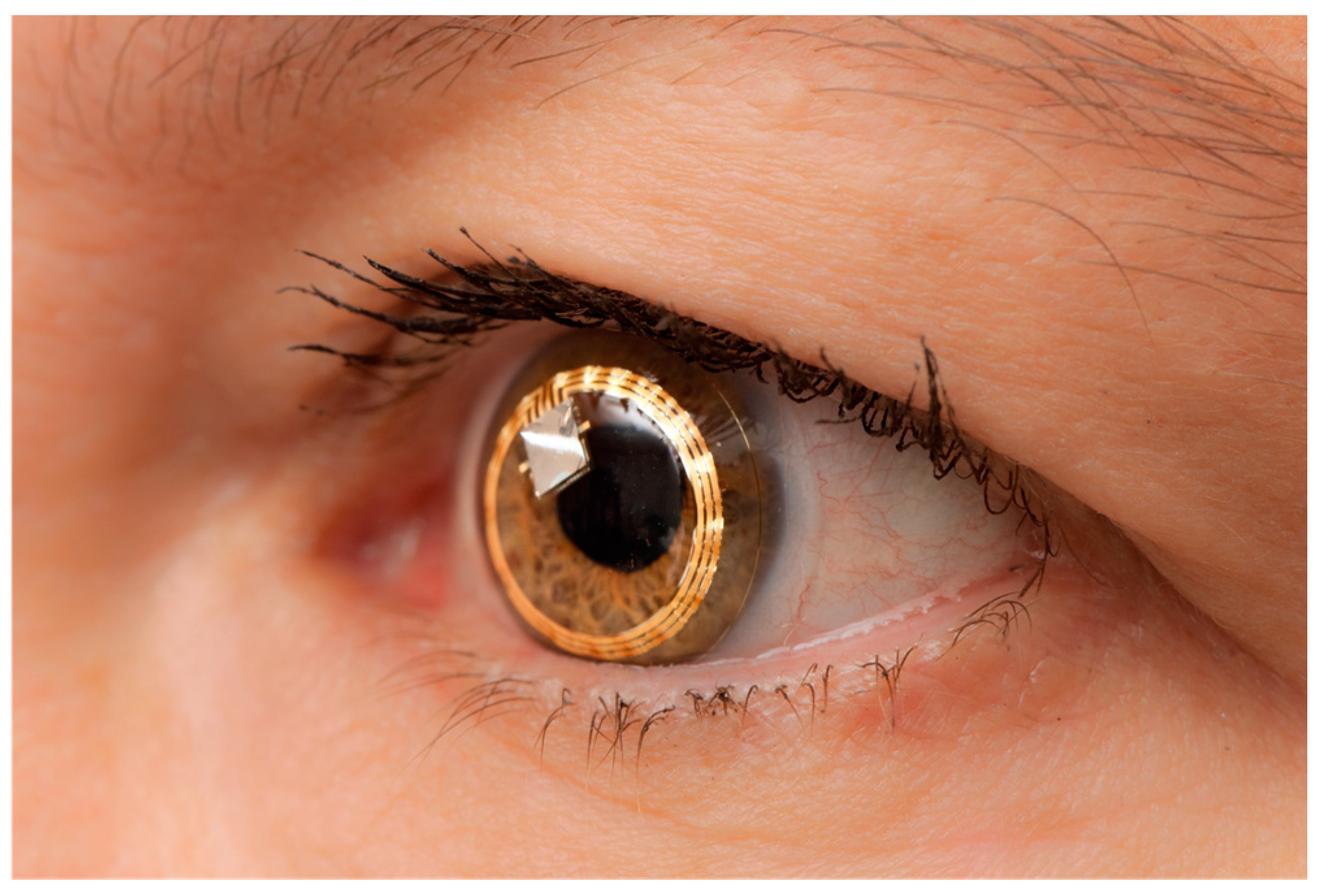

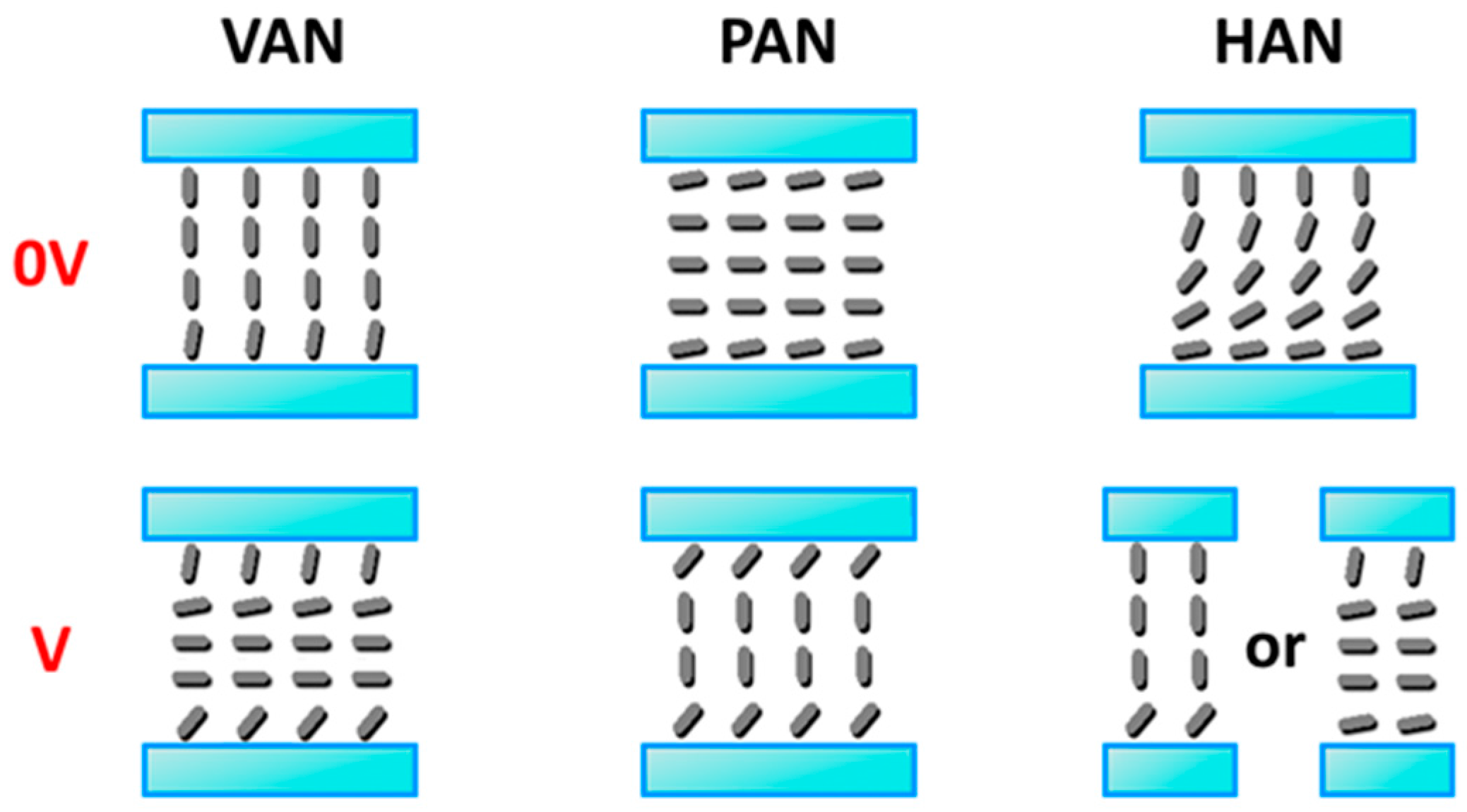
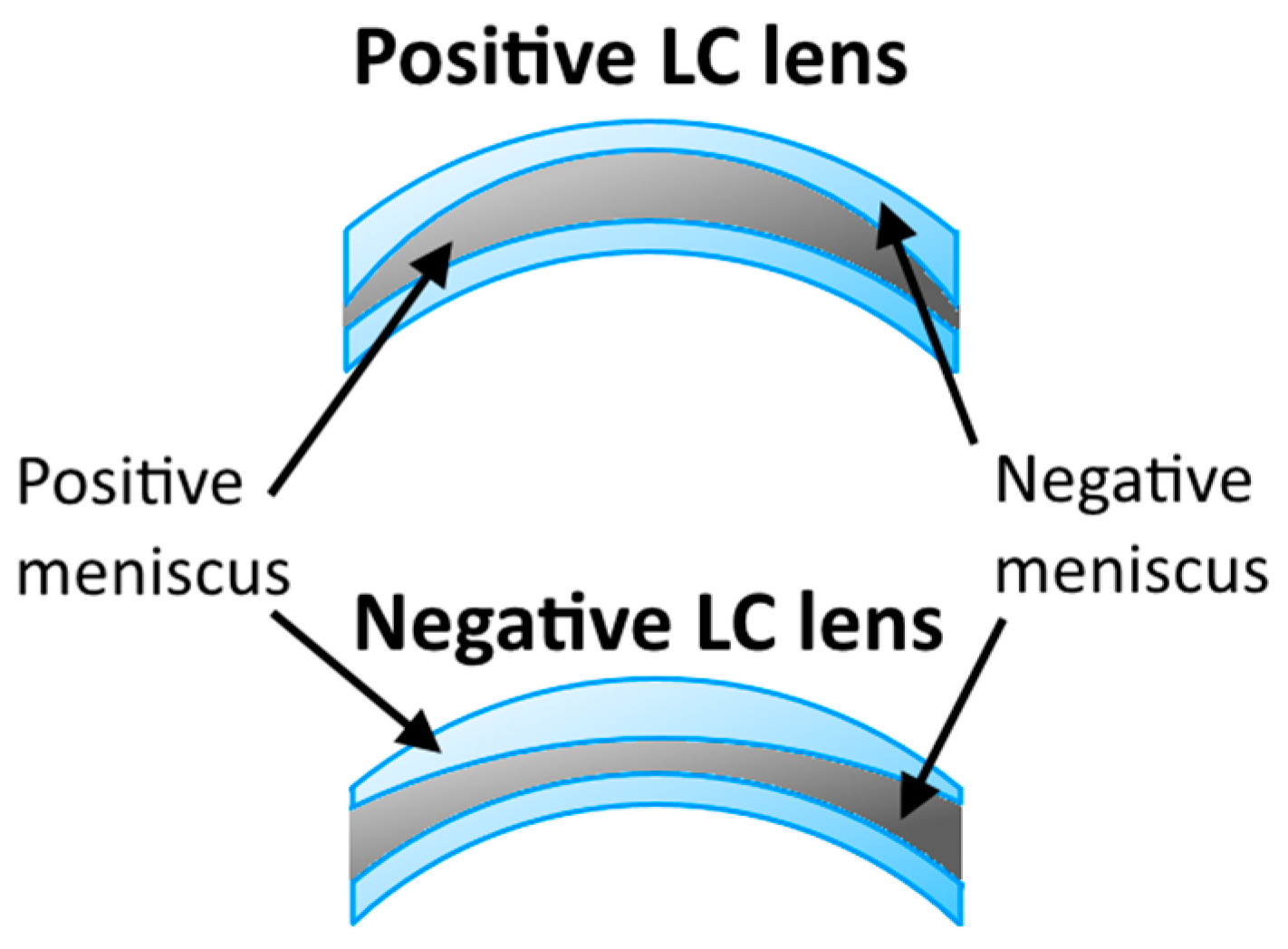
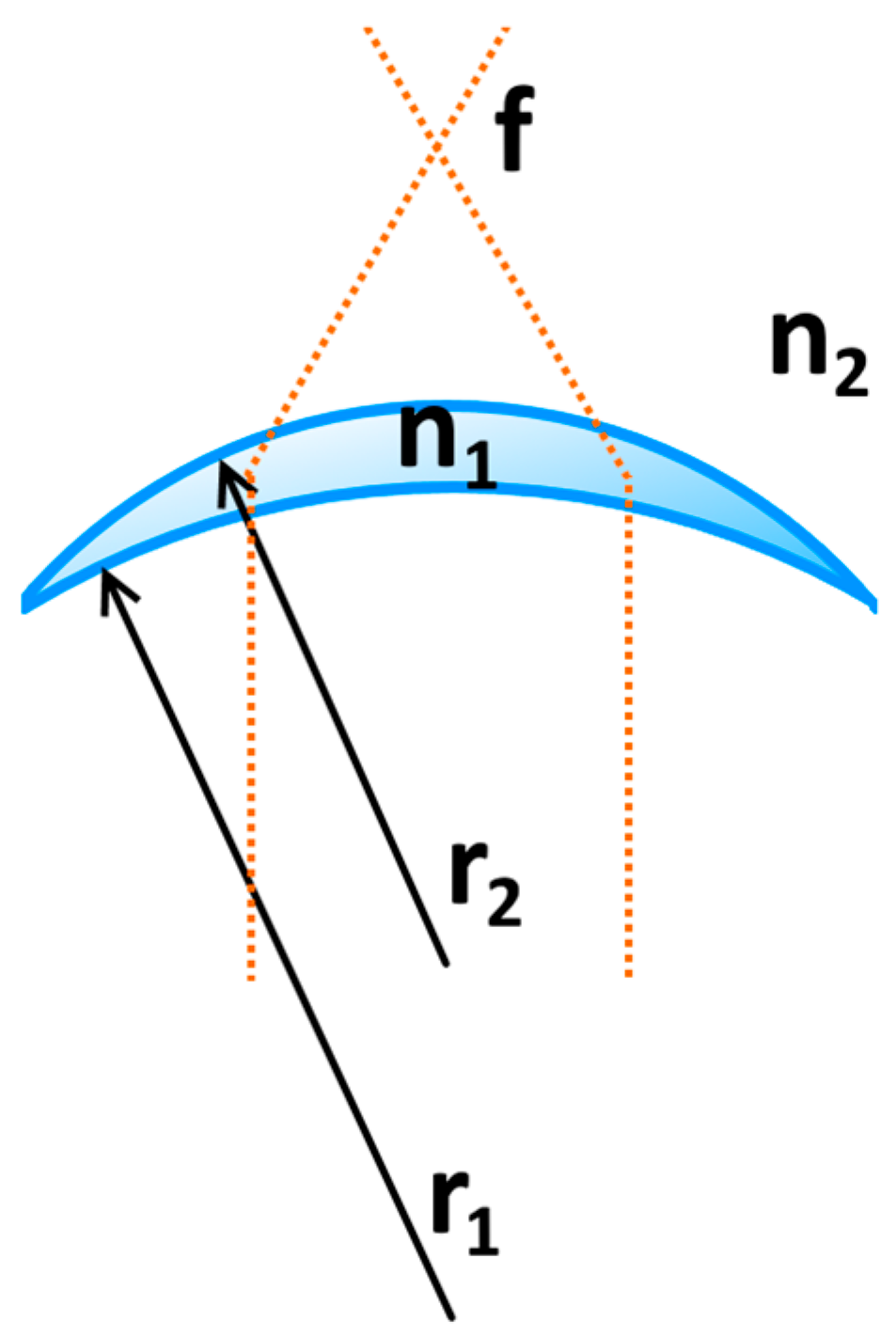
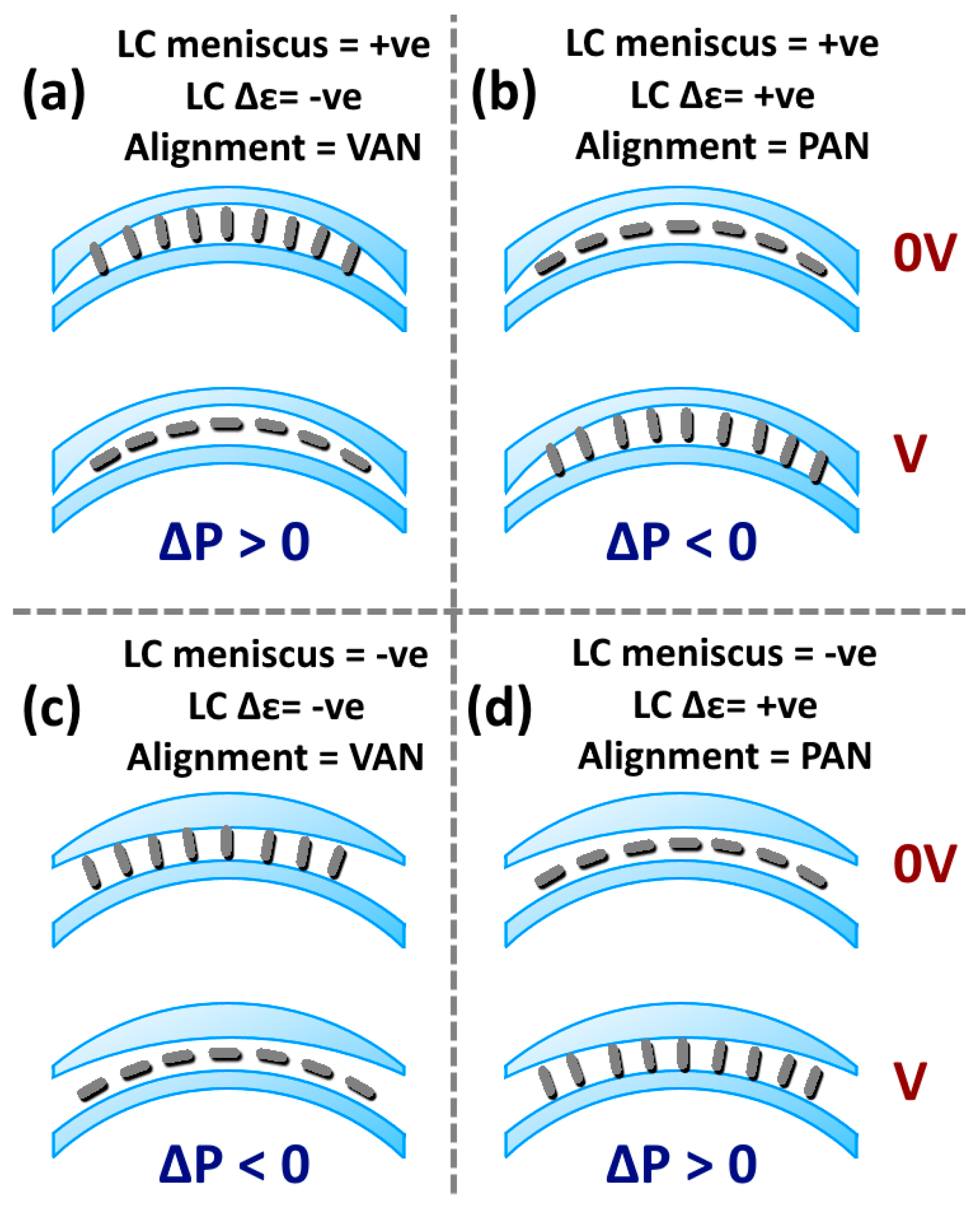
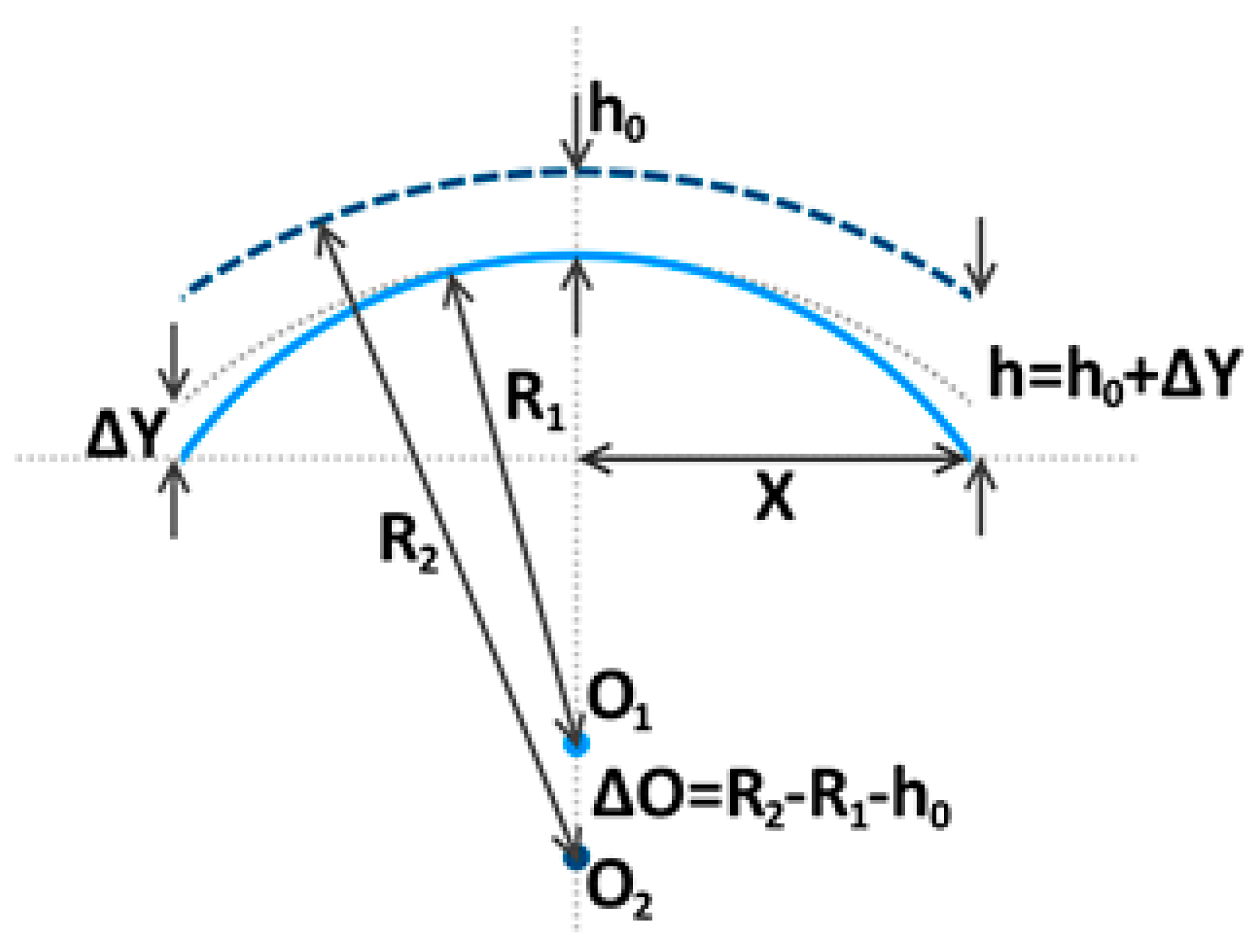
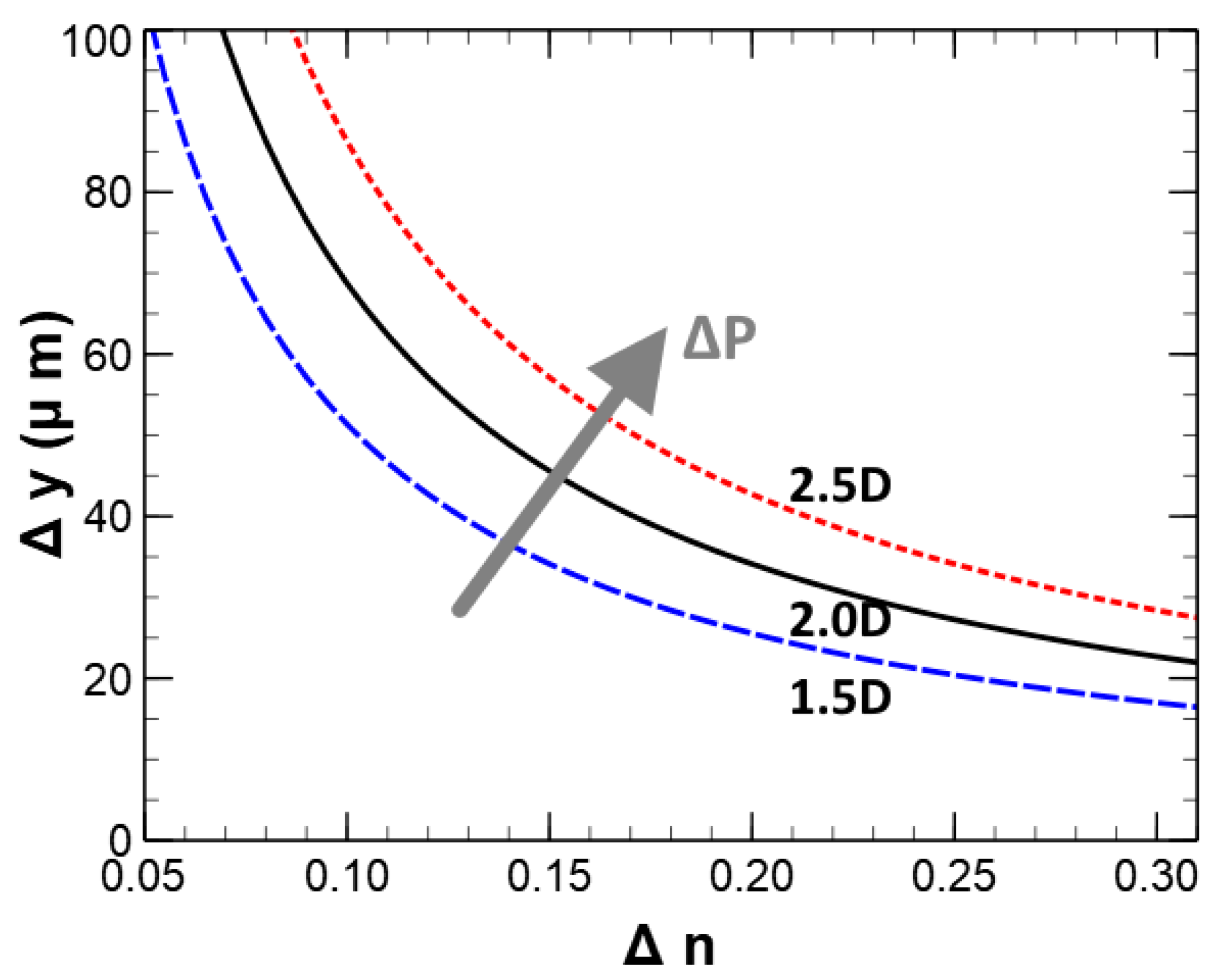
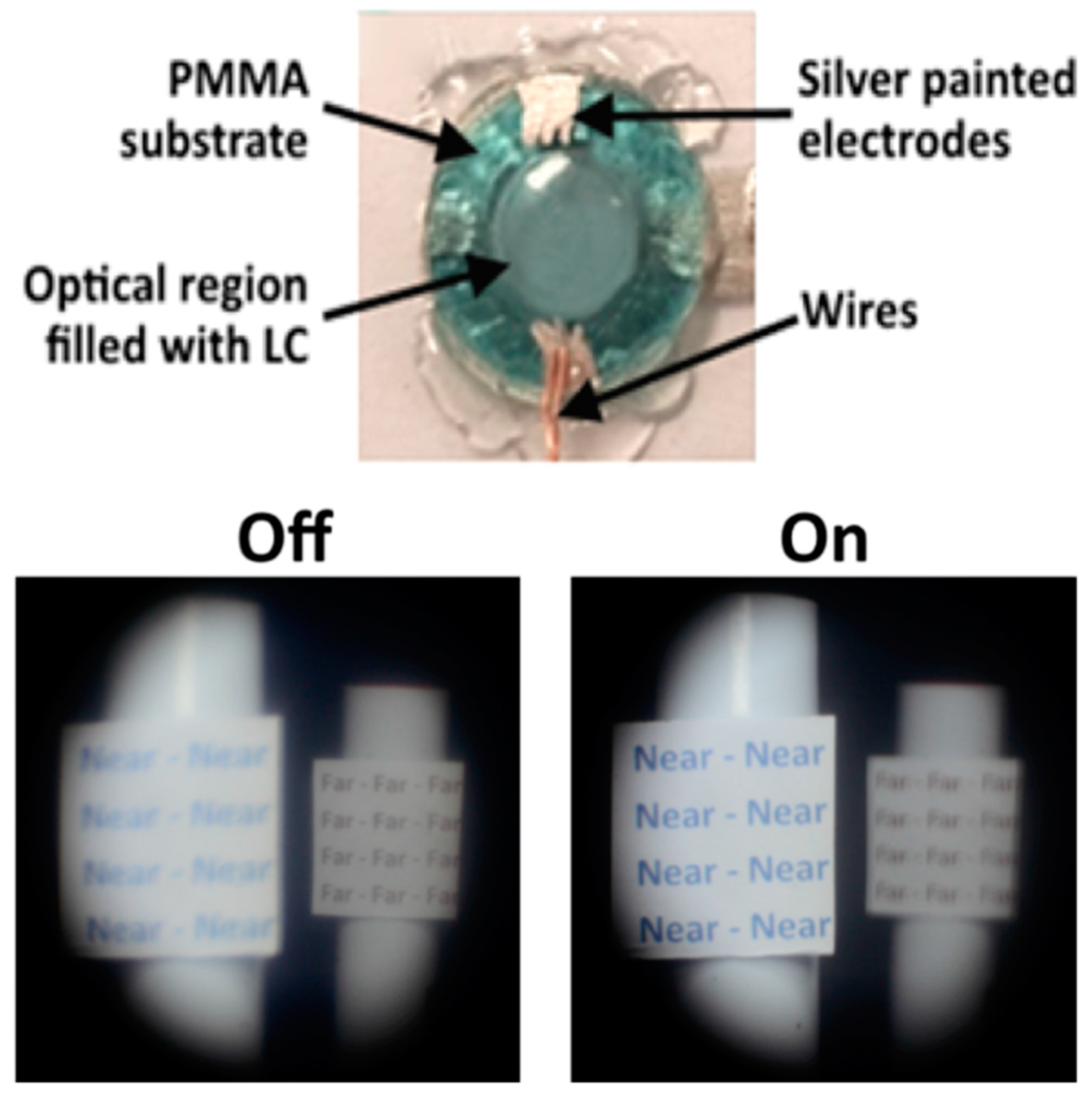
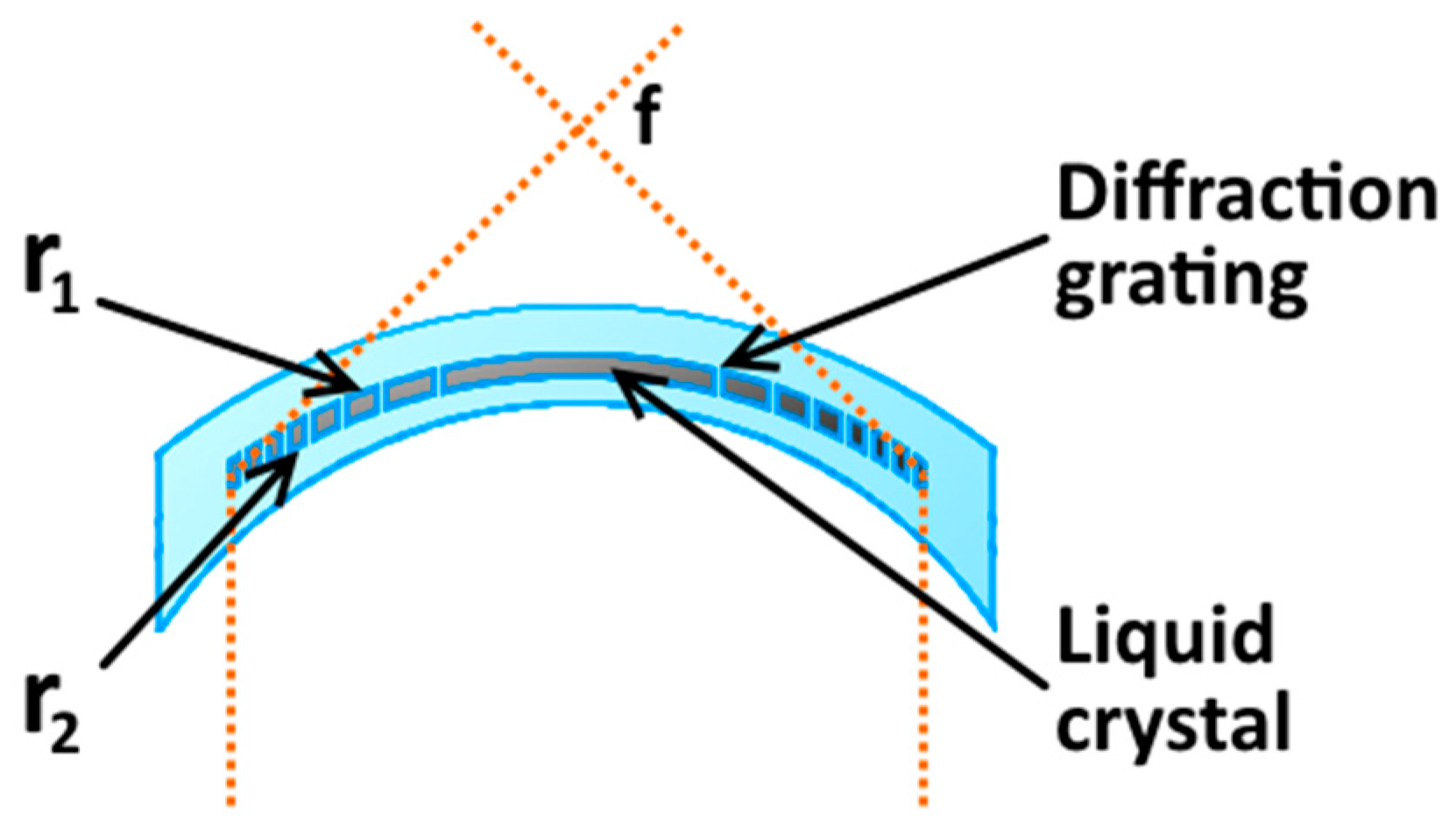
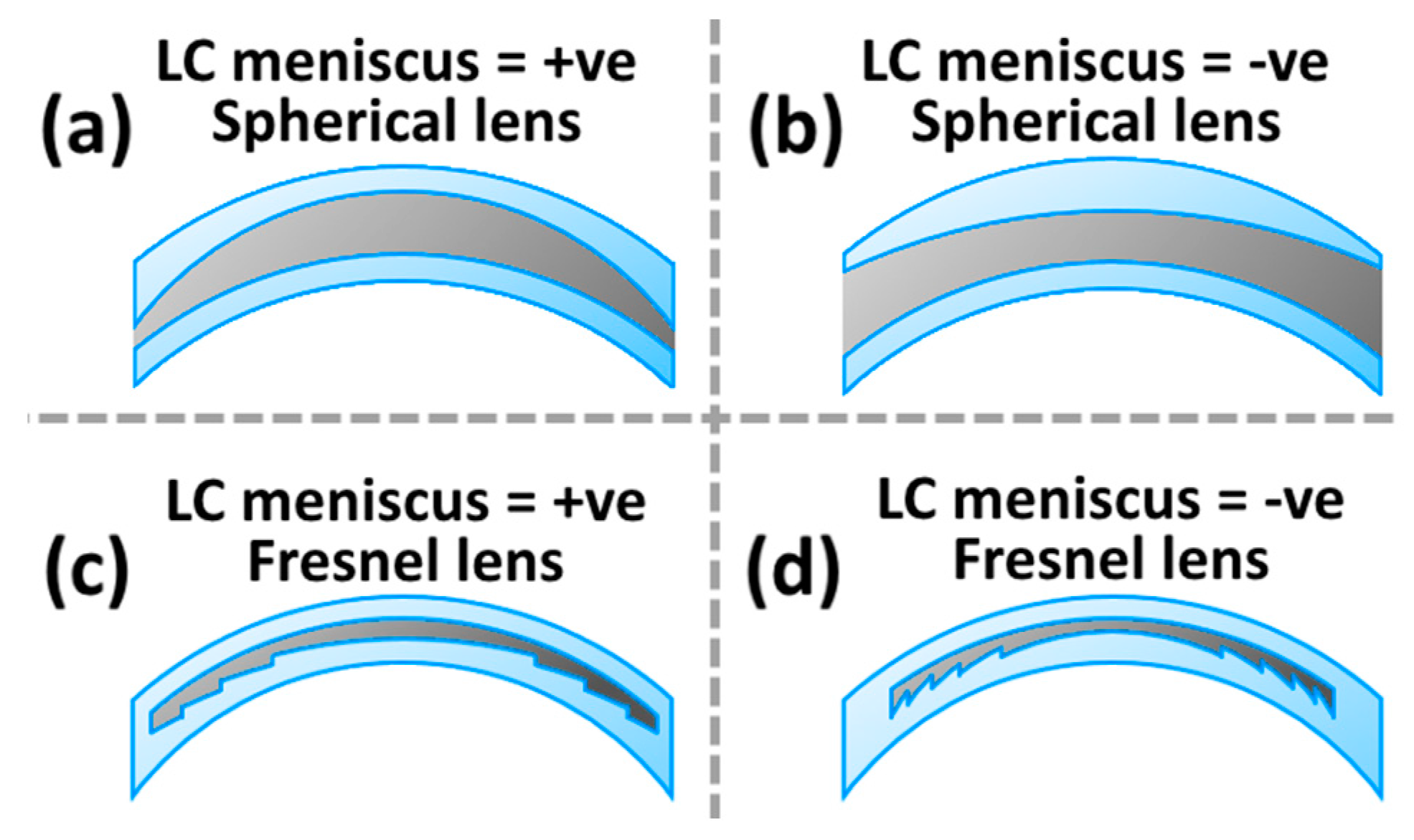
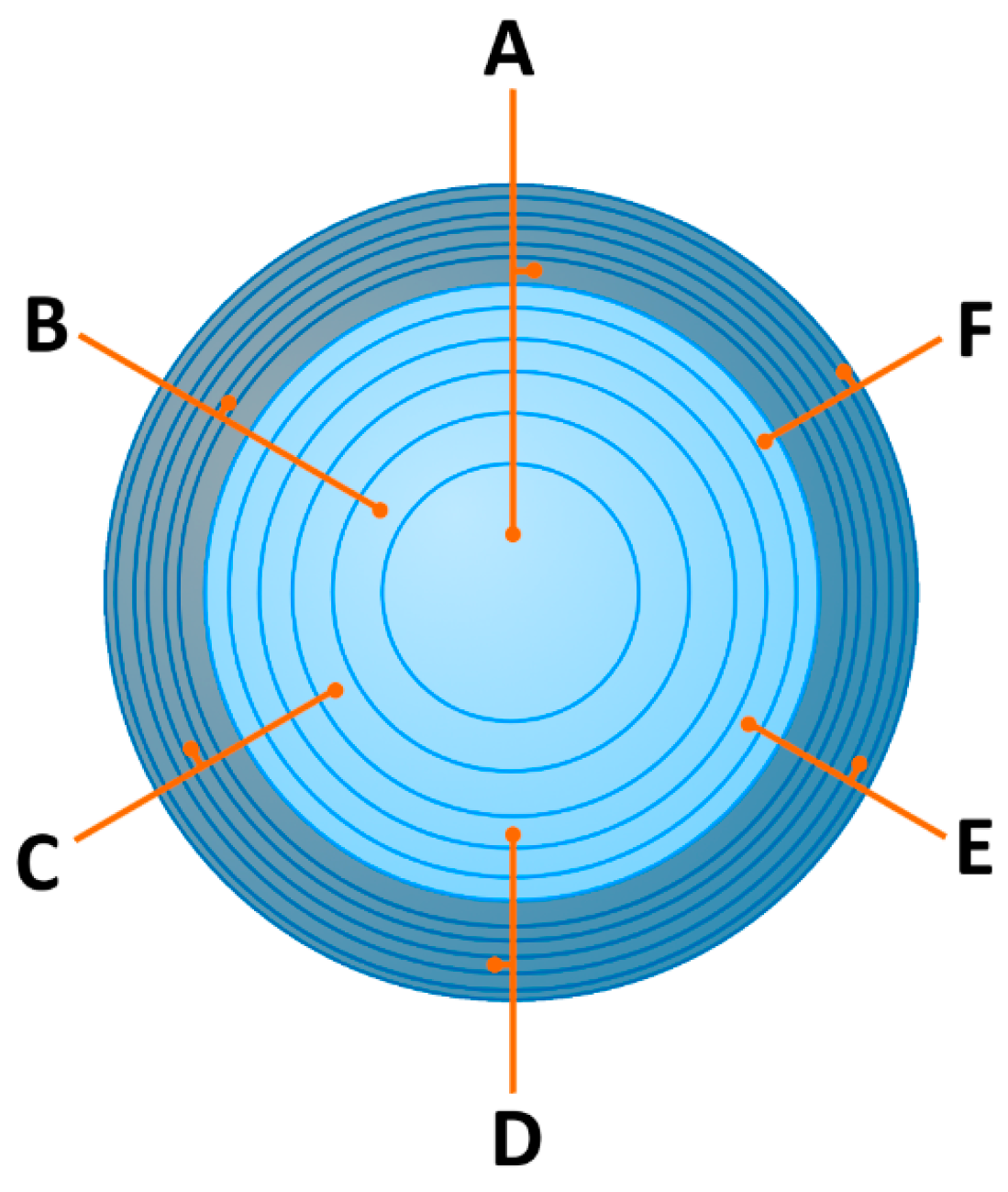
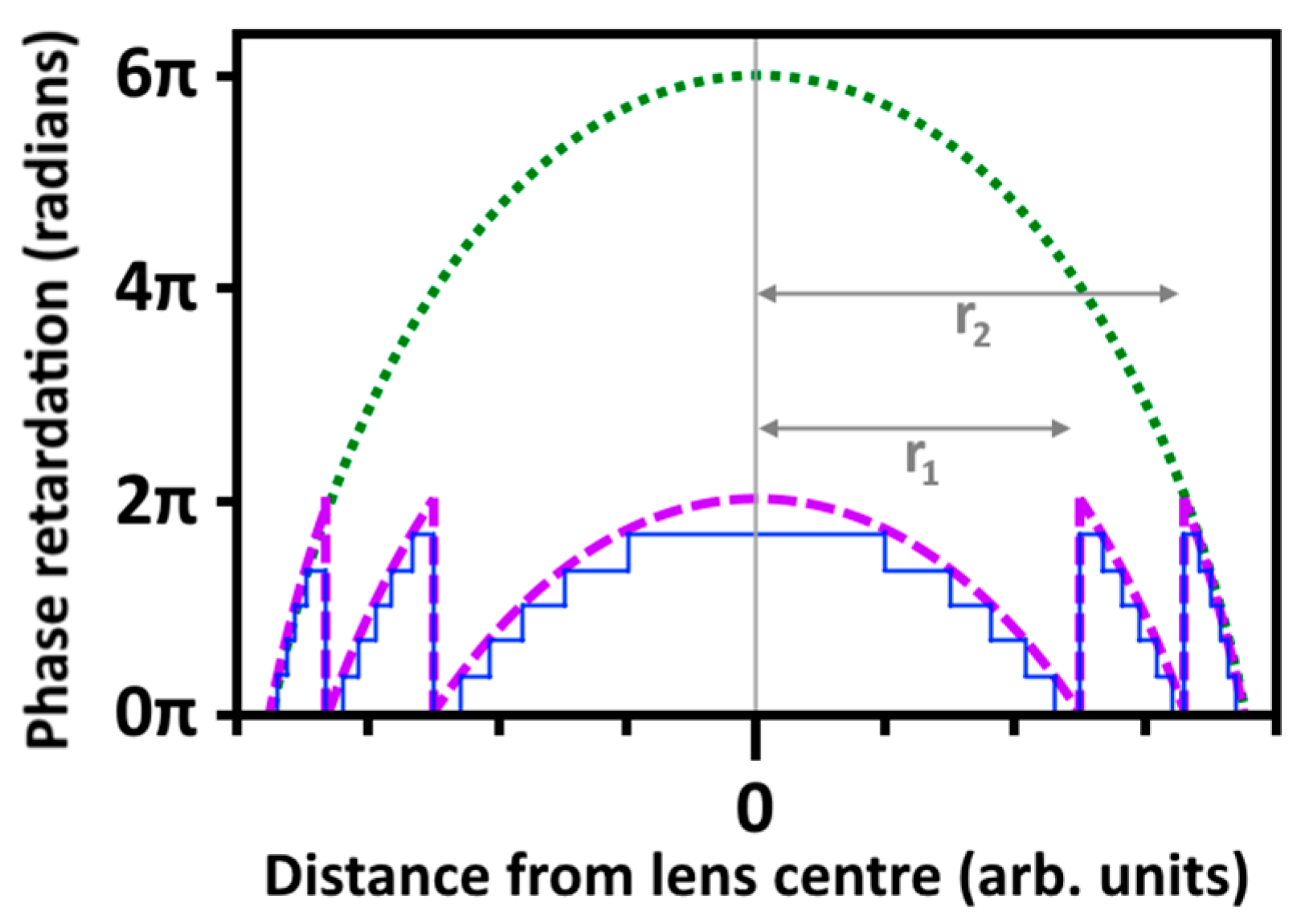
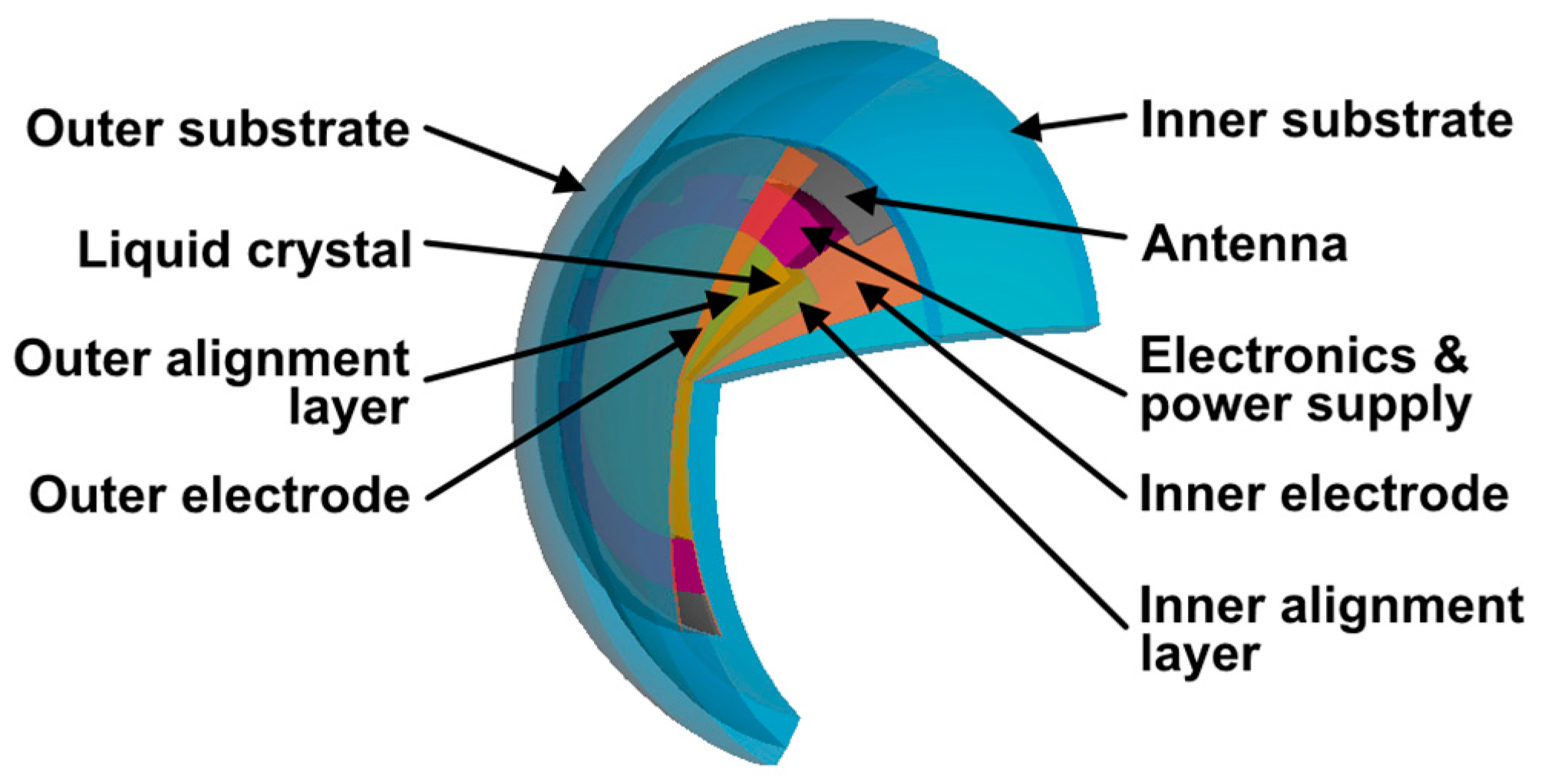

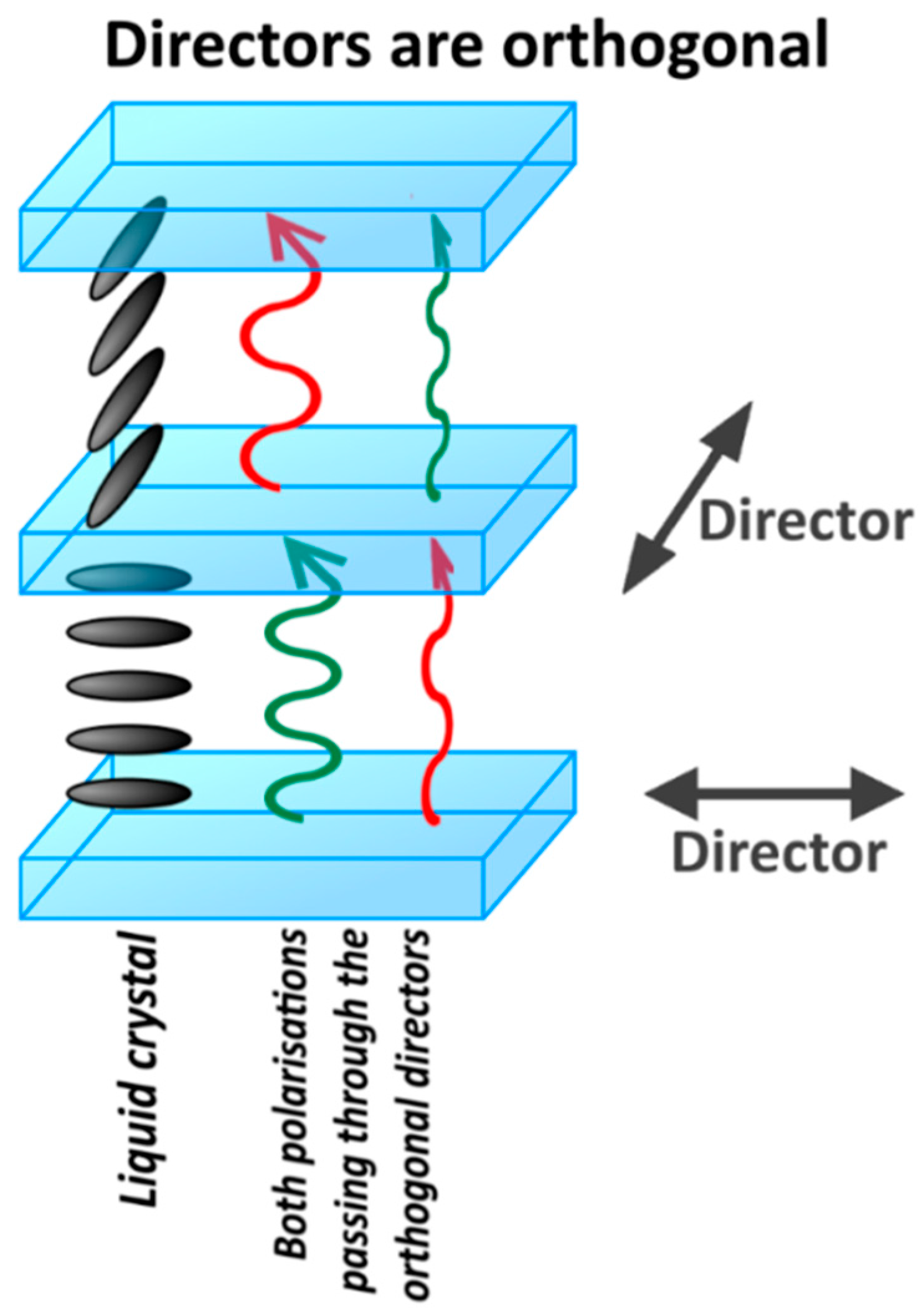
© 2018 by the authors. Licensee MDPI, Basel, Switzerland. This article is an open access article distributed under the terms and conditions of the Creative Commons Attribution (CC BY) license (http://creativecommons.org/licenses/by/4.0/).
Share and Cite
Bailey, J.; Morgan, P.B.; Gleeson, H.F.; Jones, J.C. Switchable Liquid Crystal Contact Lenses for the Correction of Presbyopia. Crystals 2018, 8, 29. https://doi.org/10.3390/cryst8010029
Bailey J, Morgan PB, Gleeson HF, Jones JC. Switchable Liquid Crystal Contact Lenses for the Correction of Presbyopia. Crystals. 2018; 8(1):29. https://doi.org/10.3390/cryst8010029
Chicago/Turabian StyleBailey, James, Philip B. Morgan, Helen F. Gleeson, and J. Cliff Jones. 2018. "Switchable Liquid Crystal Contact Lenses for the Correction of Presbyopia" Crystals 8, no. 1: 29. https://doi.org/10.3390/cryst8010029
APA StyleBailey, J., Morgan, P. B., Gleeson, H. F., & Jones, J. C. (2018). Switchable Liquid Crystal Contact Lenses for the Correction of Presbyopia. Crystals, 8(1), 29. https://doi.org/10.3390/cryst8010029







